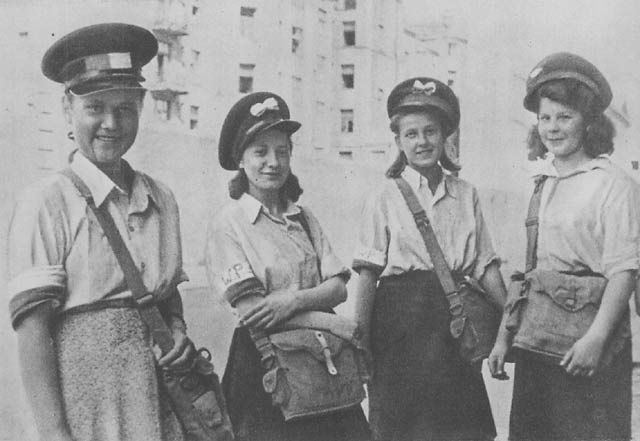Grey Ranks was the code name used by the Polish Scouting Association (ZHP) during World War II. They became a symbol of youth resistance and patriotism. The organisation, which had been operating in conspiracy since September 1939, was the largest youth underground group in Poland.
The Grey Ranks were founded on 27 September 1939, after the German and Soviet aggression against Poland, as an underground form of the Polish Scouting Association (Związek Harcerstwa Polskiego). The organisation was led by its Executive Committee, and its chairman until August 1942 was Rev. Jan Mauersberger. After his death, this function was taken over by Dr Tadeusz Kupczyński. Within the Grey Ranks there were two separate units: Organization of Boy Scouts and Organization of Girl Scouts.
The latter was initially called the “Union of Clovers”, and from 1943. “Be Ready”. The Girl Scouts were involved in a wide range of activities, from sanitary service to liaison, care of prisoners, help for children and Jews, to sabotage, intelligence and diversion.
Where did the name come from?
Initially, the name Grey Ranks referred only to the Scouts Organisation. Within its structure there was the Scouts’ Headquarters “Apiary”, which was headed successively by Florian Marciniak a.k.a. “Nowak”, Stanisław Broniewski a.k.a. “Orsza” and Leon Marszałek a.k.a. “Jan”.
The name “Szare Szeregi” itself gained nationwide recognition in 1940, although initially it functioned only in Poznań. The codename originated from an information campaign carried out by Poznan scouts. As part of this action, they distributed leaflets to the letterboxes of houses inhabited by Germans, giving true information about the forced eviction of Poles. These leaflets were signed with the initials SS, which were later developed into “Grey Ranks”. Thus, the name was adopted for the entire organisation.
The programme of the Grey Ranks was based on three slogans: “Today”, “Tomorrow” and “The day after tomorrow”, which symbolised, respectively, underground activity, armed resistance and activity in a free Poland.
Traditional Scouting terminology could not be used in the underground. Therefore, cryptonyms were introduced: the Headquarters was called “Apiary”, the regiments were renamed “hives”, the troops were renamed “swarms”, the squads were renamed “families” and the platoons were renamed “bees”.
Zawiszacy, Combat Schools and Assault Groups
The Grey Ranks were divided into three main age groups:
Zawiszacy (12-14 years old). This group comprised the youngest members of the organisation. Zawiszacy did not engage in direct combat actions but were prepared to perform various support functions. Their education was focused on secret classes, where they were taught the basics needed to rebuild Poland after the war. Their role in the Scouts’ Field Post during the Warsaw Uprising is well known.
Combat Schools (BS) (15-17 years old) – this group was more involved in underground activities including small-scale sabotage and propaganda, often as part of the ‘Wawer-Palmiry’ organisation. Its activities were aimed at maintaining the national spirit and disinforming the Germans. BS scouts were also involved in gathering intelligence and passing it on to the Home Army.
The Assault Groups (GS) (over 18) was the oldest group, subordinated to the Home Army’s Diversion Directorate (Kedyw). It was the most militantly active part. It carried out a variety of missions, from blowing up bridges and trains to recapturing prisoners and assassinating German officers. During the Warsaw Uprising, the assault battalions “Zośka” and “Parasol” fought on various fronts, suffering huge losses.
On the combat trail and in propaganda activities
As mentioned, the most advanced combat operations were the responsibility of the Assault Groups. Their first action was Operation “Wreath II”, which consisted in blowing up railway tracks near Kraśnik on New Year’s Eve 1942/1943. A special unit, the Third Separate Company, known under the code names “Agat”, “Pegasus” and “Umbrella” was also formed within these groups. Its main task was to eliminate the most dangerous Germans, mainly high SS officers and German police.
The most famous combat actions include above all the “Arsenal Action”, during which 21 prisoners were rescued, including Jan Bytnar “Rudy”; the action in Celestynow, thanks to which a transport of prisoners to Auschwitz was rescued; and the “Kutschera” Action, during which the German Franz Kutschera, commander of the Warsaw police and SS, was executed.
During the Warsaw Uprising – the largest Polish anti-German uprising, which began on 1 August 1944, the Grey Ranks fought in the ranks of the Home Army – the largest underground army in German-occupied territories. The youngest, Zawiszacy, were responsible for liaison and the operation of the Scouts’ Field Post Office, which was the only source of information about the fate of relatives for many Varsovians.
The Scouts in conspiracy were also involved in carrying out a wide-ranging educational and propaganda campaign, known as Operation “M”, aimed at influencing unorganised youth. As part of it, numerous magazines were published, such as “Source”, ” Oaks”, ” The Pathfinder”, ” The Youth Magazine” and “Twilight”. In addition, the organisation published brochures and books, including well-known items such as ” On the Vocation of Our Generation”, “The Great Game”, “Foreman” and “Stones on a Rampart”.
When the Soviets entered
In mid-1944, at the top of its development, the Grey Ranks associated more than 15,000 young people, including around 7,000 Girl Scouts.
When, on 17 January 1945 Red Army entered Warsaw, the then head of the organisation, Leon Marszałek, issued an order that wherever Soviet troops entered, the organisation would be disbanded. This brought an end to the organisation, which for years had been a bastion of youth resistance and spirit.





